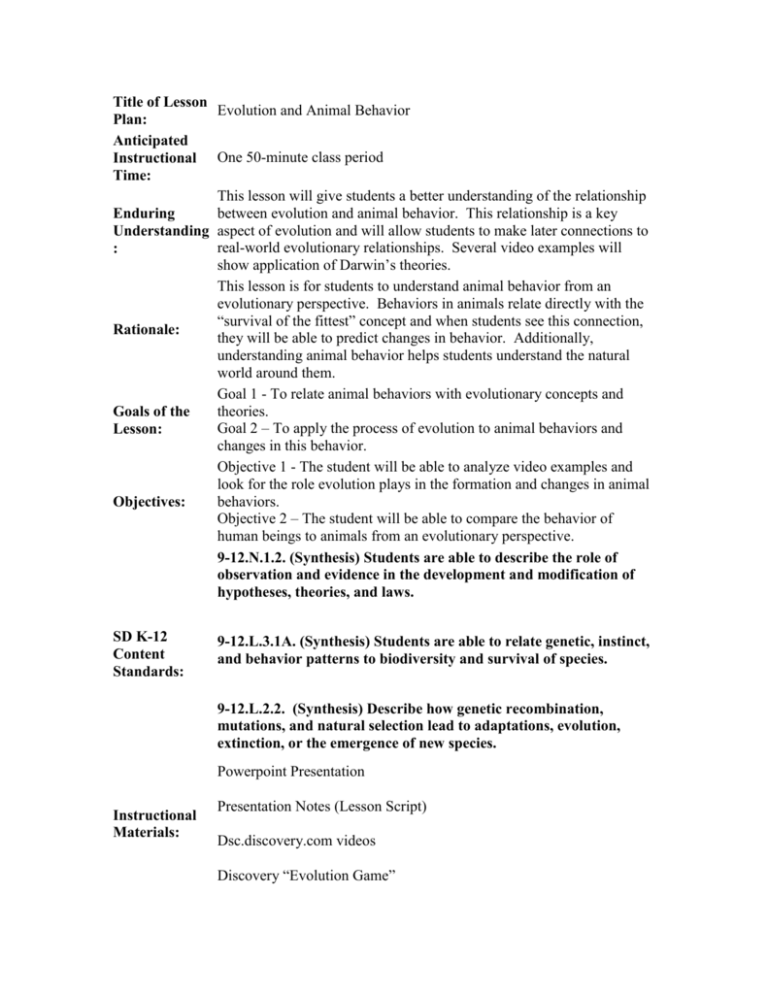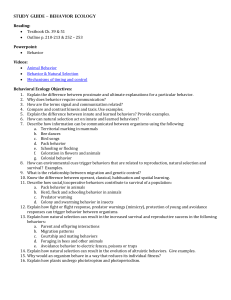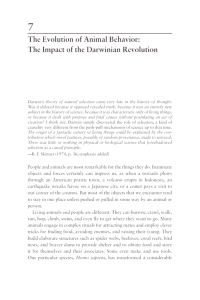Evolution and Animal Behavior
advertisement

Title of Lesson Evolution and Animal Behavior Plan: Anticipated Instructional One 50-minute class period Time: This lesson will give students a better understanding of the relationship between evolution and animal behavior. This relationship is a key Enduring Understanding aspect of evolution and will allow students to make later connections to real-world evolutionary relationships. Several video examples will : show application of Darwin’s theories. This lesson is for students to understand animal behavior from an evolutionary perspective. Behaviors in animals relate directly with the “survival of the fittest” concept and when students see this connection, Rationale: they will be able to predict changes in behavior. Additionally, understanding animal behavior helps students understand the natural world around them. Goal 1 - To relate animal behaviors with evolutionary concepts and theories. Goals of the Goal 2 – To apply the process of evolution to animal behaviors and Lesson: changes in this behavior. Objective 1 - The student will be able to analyze video examples and look for the role evolution plays in the formation and changes in animal behaviors. Objectives: Objective 2 – The student will be able to compare the behavior of human beings to animals from an evolutionary perspective. 9-12.N.1.2. (Synthesis) Students are able to describe the role of observation and evidence in the development and modification of hypotheses, theories, and laws. SD K-12 Content Standards: 9-12.L.3.1A. (Synthesis) Students are able to relate genetic, instinct, and behavior patterns to biodiversity and survival of species. 9-12.L.2.2. (Synthesis) Describe how genetic recombination, mutations, and natural selection lead to adaptations, evolution, extinction, or the emergence of new species. Powerpoint Presentation Instructional Materials: Presentation Notes (Lesson Script) Dsc.discovery.com videos Discovery “Evolution Game” Participant Materials: References Pencil and Notebook Textbook http://faculty.ed.uiuc.edu/g-cziko/twd/pdf/twd07.pdf - Site is used as an outline for the lesson - Contains Darwin’s ideas on many concepts in animal behavior - Contains examples of behaviors http://animal.discovery.com/videos/top-10-bloodsuckers-vampirefinches.html - Shows the evolution of “instinctive” behavior http://dsc.discovery.com/videos/life-cheetahs-hunt-ostrich.html - Same purpose as above video. http://news.discovery.com/videos/news-lizards-show-evolution-inaction.html - Evolution in action http://dsc.discovery.com/videos/planet-earth-shallow-seas-dolphinwaves.html Shows cooperation in hunting techniques. http://dsc.discovery.com/videos/planet-earth-ice-worlds-antarcticpenguin-fathers.html Shows cooperation for survival in a freezing environment. http://science.discovery.com/interactives/literacy/darwin/darwin.htm l This is an interactive online game. It shows how the environment fuels evolution through natural selection. It also contains a quiz. Lesson Script: Evolution and Animal Behavior Note: The attached powerpoint follows this outline and includes video examples of the behaviors discussed below. I. Behavior a. Instinctive (migrations, hibernation, mating rituals) Darwin’s theory of evolution supports the idea that a natural variation in animal behavior led to the continuation of helpful behaviors and the halting of harmful ones. Behaviors that differ from the normal behavior, but are effective can be seen as instinctive behaviors that were acquired due to the natural variation of individuals within a species. b. Learned (Avoiding predators, hunting techniques, finding where water is) These behaviors are not passed on from generation to generation, but are instead learned throughout the life of the organism. Behaviors are consistent for all individuals and were not present at birth. II. Effect of environment on behavior a. Constantly changing environment forces evolution, OR… b. Natural variation in animal behavior leads to evolution *** The question is, do animals change as a result of the environment, OR do animals have natural genetic variation that leads to different behaviors which can evolve into instinctive behaviors? Darwin sides with the second option. When a goose egg hatches, the gosling must find its mother. What is the gosling’s way of determining where its mother is? First moving object is thought to be its mother. In captivity this can cause the gosling to think that anything it sees moving first is its mother. III. Effects of Other Organisms a. Predation b. Competition by different species (such as the many big cats of Africa) IV. Altruism and Cooperation a. “You scratch my back, I’ll scratch yours” mentality b. Working together is the best means of survival V. Mutualism a. Both animals benefit from the relationship b. Think about the cleaner fish and the shark, or pollinating animals (bees) VI. Evolution Online Quiz and Game http://science.discovery.com/interactives/literacy/darwin/darwin.html





